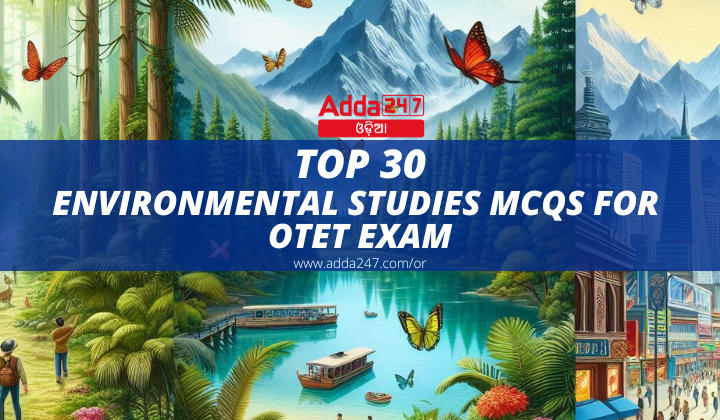Top 30 Environmental Studies MCQS For OTET Exam
- Environmental studies is defined as the branch that deals with the:
- A) Design, study, and discovery of new materials.
- B) Study of humanities, social, biological, and physical sciences.
- C) Incorporation of information and physical sciences.
- D) Approach about the natural world and the impact of humans on its integrity.
- Answer: D) Approach about the natural world and the impact of humans on its integrity.
- Which of the following statements about the Zoological Survey of India (ZSI) is true?
- A) It was established in 1890 at the Royal Botanical Gardens, Calcutta.
- B) It is the first crocodile conservation breeding center in Asia.
- C) It was established in 1916 to do an organized survey of fauna in India.
- D) It was established in 1982 for research in Wildlife Management.
- Answer: C) It was established in 1916 to do an organized survey of fauna in India.
- Which layer of the atmosphere contains the ozone responsible for the absorption of UV light?
- A) Stratosphere
- B) Troposphere
- C) Mesosphere
- D) None of these
- Answer: A) Stratosphere
- The estimated percentage of the forest land that ideally India should have is:
- A) 50%
- B) 15%
- C) 33%
- D) 44%
- Answer: C) 33%
- Which two countries of the world constitute about 57% of the large dams?
- A) India and China
- B) India and Brazil
- C) China and Brazil
- D) India and Japan
- Answer: A) India and China
- The essential non-metallic minerals are:
- A) Granite, marble, limestone
- B) Gold, silver, platinum
- C) Iron, aluminum, zinc, copper
- D) Coal, clay, cement, silica
- Answer: D) Coal, clay, cement, silica
- Integrated Crop Management is defined as a process to:
- A) Use traditional methods for growing crops.
- B) Use alternatives to inorganic fertilizers and pesticides.
- C) Both (A) and (B)
- D) None of the above
- Answer: C) Both (A) and (B)
- Which three edible plant species constitute about 60% of the world’s food energy intake?
- A) Wheat, Barley, Oat
- B) Wheat, Rice, Maize
- C) Wheat, Barley, Maize
- D) None of these
- Answer: B) Wheat, Rice, Maize
- Which of the following is not a measure of sustainable water management?
- A) Preventing leakage from dams and canals
- B) Reducing the rate of surface run-off water.
- C) Preventing loss in municipal pipes.
- D) Building small reservoirs in place of a few mega projects.
- Answer: B) Reducing the rate of surface run-off water.
- Which element is considered the largest source of the world’s commercial energy consumption?
- A) Coal
- B) Oil
- C) Natural gas
- D) Nuclear
- Answer: B) Oil
- What are the two forms of alcohol included in biofuels?
- A) Ethanol and methanol
- B) Ethanol and propanol
- C) Methanol and propanol
- D) None of the above
- Answer: A) Ethanol and methanol
- What is the world’s largest potential source of biomass energy?
- A) Animal waste
- B) Industrial waste
- C) Fibrous waste of the paper industry
- D) Fibrous waste of the sugar industry
- Answer: D) Fibrous waste of the sugar industry
- The functional aspects of the ecosystem are:
- A) Energy cycles
- B) Nutrient cycles
- C) Food chains
- D) All of the above
- Answer: D) All of the above
- Which of the following is also called Detrivores?
- A) Herbivores
- B) Decomposers
- C) Carnivores
- D) None of the above
- Answer: B) Decomposers
- What are ‘keystone’ species in an ecosystem?
- A) The species whose elimination can seriously affect the ecosystem.
- B) The species whose elimination can benefit the ecosystem.
- C) The species whose elimination would not affect the ecosystem.
- D) None of the above
- Answer: A) The species whose elimination can seriously affect the ecosystem.
- What is the correct order of the 3R principle?
- A) Recycle, Reuse, Reduce
- B) Reuse, Reduce, Recycle
- C) Reduce, Reuse, Recycle
- D) None of the above
- Answer: C) Reduce, Reuse, Recycle
- In which year was the amendment of the Forest Conservation Act enacted?
- A) 1976
- B) 1988
- C) 1980
- D) 1971
- Answer: B) 1988
- Hepatitis A is what kind of disease?
- A) Food contamination
- B) Water-borne disease
- C) Air-borne disease
- D) Both (A) and (B)
- Answer: D) Both (A) and (B)
- Which category is the worst sufferer of environmental destruction?
- A) Moderate class
- B) Rich
- C) Poor
- D) All of the above
- Answer: C) Poor
- Name the most frequent and naturally occurring disaster.
- A) Earthquake
- B) Flood
- C) Tsunami
- D) None of the above
- Answer: B) Flood
- How many biodiversity hotspots exist in the world?
- A) 34
- B) 30
- C) 35
- D) 36
- Answer: D) 36
- What drug is associated with the plant source of coffee or tea?
- A) Camphor
- B) Opium Poppy
- C) Caffeine
- D) Thorn Apple
- Answer: C) Caffeine
- When is World Environment Day celebrated?
- A) June 5th
- B) June 6th
- C) June 8th
- D) June 10th
- Answer: A) June 5th
- What factors cause eutrophication?
- A) Increment in plant nutrients
- B) Using fertilizers excessively
- C) Both (A) and (B)
- D) None of the above
- Answer: C) Both (A) and (B)
- What would happen to Earth in the absence of ants?
- A) Destruction of life
- B) Little impact
- C) Reduction in termites
- D) No effect
- Answer: A) Destruction of life
- Which activity can lower the water table?
- A) Overgrazing
- B) Human population growth
- C) Soil erosion
- D) Over extraction of groundwater
- Answer: D) Over extraction of groundwater
- Jowar and Bajra grow in regions having:
- A) High amount of moisture
- B) Low amount of moisture
- C) No moisture
- D) None of the above
- Answer: B) Low amount of moisture
- Why is the sky blue?
- A) Water vapor is present
- B) Sunlight gets scattered due to air molecules
- C) Blue light gets absorbed by the air
- D) Blue light is emitted through the atmosphere
- Answer: B) Sunlight gets scattered due to air molecules
- What is the cause of soil pollution?
- A) Acid rain
- B) Ozone
- C) Aerosol
- D) None of the above
- Answer: A) Acid rain
- Why are radiations harmful?
- A) Radiations lead to skin cancer
- B) Radiations cause anemia
- C) Radiations change body tissues
- D) Radiations are not stable
- Answer: A) Radiations lead to skin cancer
















